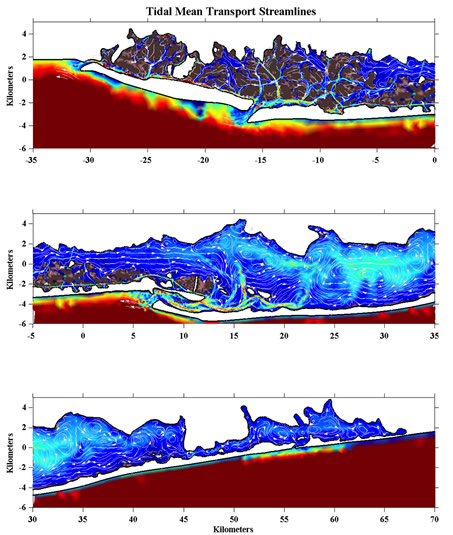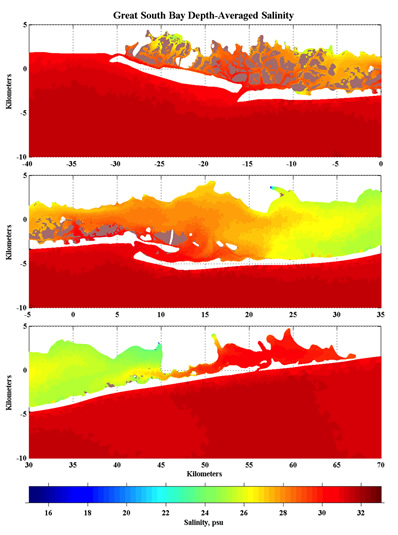Charles Flagg, Robert Wilson
Further Information
FVCOM is a three-dimensional primitive equation ocean model that conserves momentum, energy, heat, salinity and density, includes advanced turbulent closure schemes, and matches a quadratic bottom drag with the interior through a logarithmic bottom boundary layer. The 3-D solution is determined using a mode-splitting technique by which a 2-D external mode is updated at frequent intervals while the more slowly evolving internal mode is obtained less frequently. The model is particularly suited to applications where the advection and mixing of salt, heat, nutrients, and biological constituents are important issues. In the FVCOM formulation the shape of the volume elements is arbitrary which means that the elements can be adapted to local conditions rather than attempting some global balancing act that minimizes the differences between the actual and grid geometries.
We have applied the FVCOM circulation model to the GSB lagoonal system which extends nearly 100 km from East Rockaway Inlet to Moriches Bay with the intent to include all four of the tidal inlets between the coastal ocean and the Bay. The grid extends southward to the edge of the continental shelf, westward to the entrance to New York harbor and eastward to Montauk Point with open ocean boundary conditions provided by a larger scale ADCIRC model of the New York Bight. The GSB model includes estimates of the climatological mean surface and groundwater inputs of the fresh water that together total about 15 m3/s. Since little is known about the groundwater flow distribution, we have assumed a longitudinally uniform flow that decreases exponentially from the north shore with a total discharge equal to that of the surface flow. Because of the need to resolve the extremely complicated channeling of the Hempstead and East Bay portions of GSB, the grid spacing ranges to as little as 20m in that region while in the more open waters of the central Bay, the grid spacing is more typically 400m. To date we have explored the tidal-mean circulation and salinity balances while forcing the model with the M2 semi-diurnal tide with and without along-bay wind stress. The boundary conditions and air-sea interaction parameters for longer-term model runs extending over entire seasons are beingassembled now for use on the New York BlueGene super computer at Brookhaven National Laboratory.





